A delicious tradition inherited from our ancestors, a product of the mixing of Spaniards, Africans and indigenous people.
Todos los años al llegar el mes de diciembre, mi familia y yo acostumbramos a preparar nuestras tradicionales Hallacas. Se trata de un plato típico de Venezuela, el cual forma parte de nuestra gastronomía desde tiempos de la colonización española.
No se tiene un registro muy exacto de su origen, sin embargo, por generaciones se ha transmitido oralmente las posibles versiones del cómo se originó éste peculiar platillo, que conjuga en su preparación una multiplicidad de ingredientes que evocan sabores de distintas regiones del mundo que conforman la identidad venezolana en cuanto a cocina se refiere, y que además, le ha otorgado el apodo de “multisápida”.
English
Every year when the month of December arrives, my family and I usually prepare our traditional Hallacas. It is a typical dish from Venezuela, which has been part of our gastronomy since the time of Spanish colonization.
There is no very exact record of its origin, however, for generations possible versions of how this peculiar dish originated, which combines in its preparation a multiplicity of ingredients that evoke flavors from different regions of the world that make up the dish, have been transmitted orally. the Venezuelan identity in terms of cuisine, and which has also given it the nickname “multisápida”.

La historia más conocida y difundida que recuerdo es que en la Caracas de antaño (en el siglo 18 ó 19), en las casas de la gente adinerada acostumbraban a preparar grandes banquetes con muchísimos platos suculentos, a los cuales los peones y esclavos no tenían acceso, por evidentes razones, sin embargo, luego de que el festín acababa, las sobras eran recogidas por los indígenas y afrodescendientes, (quienes eran los esclavos de dichas casas y haciendas), y mezcladas en un rústico guiso, el cual cubrían con masa de maíz pilado o pelado, y envuelta en hojas de plátano ahumadas las cuales llevaban consigo a los sembradíos, dónde pasaban el día labrando la tierra, ése era el alimento que ellos consumían.
Se dice que ese improvisado pan relleno de tantas delicias, era llamado por los indígenas Ayaca ó Hallaca, que en la lengua nativa significa paquete, bulto o bollo, y es que la hallaca aún conserva ésa forma de pequeño paquete, el cual contiene ese magnífico regalo culinario muy bien envuelto en la aromática hoja de plátano ahumada, que tantos recuerdos nos trae a la memoria al olerlo.
Dicen que la hallaca es primita de los tamales mexicanos y colombianos, y de la humita peruana, se parecen un poco quizás en su forma, y en qué ellas también son hechas con maíz, pero nuestra Hallaca, es más compleja, con personalidad propia, rica en sabores y aromas, en fusión de herencias gastronómicas, en historias que se entretejen en su cocción.
English
The best known and most widespread story that I remember is that in the Caracas of yesteryear (in the 18th or 19th century), in the houses of wealthy people they used to prepare large banquets with many succulent dishes, to which the peons and slaves had no access. access, for obvious reasons, however, after the feast was over, the leftovers were collected by the indigenous and Afro-descendant people, (who were the slaves of said houses and haciendas), and mixed in a rustic stew, which they covered with dough. of chopped or peeled corn, and wrapped in smoked banana leaves which they took with them to the fields, where they spent the day tilling the land, that was the food they consumed.
It is said that this improvised bread filled with so many delicacies was called by the indigenous people Ayaca or Hallaca, which in the native language means package, bundle or bun, and the hallaca still retains that shape of a small package, which contains that magnificent culinary gift beautifully wrapped in the aromatic smoked banana leaf, which brings back so many memories when smelling it.
They say that the hallaca is a cousin of the Mexican and Colombian tamales, and of the Peruvian humita, perhaps they are a little similar in their shape, and in that they are also made with corn, but our Hallaca is more complex, with its own personality, rich in flavors and aromas, in fusion of gastronomic heritages, in stories that are interwoven in its cooking.

La Hallaca, que tiene nacionalidad venezolana únicamente, tiene un corazón hecho de una exquisita mezcla de carnes (res, cerdo, gallina o pollo, tocino) guisadas juntas con mucha cebolla, cebollín, ají dulce venezolano, ajo, onoto, junto a los caldos de todas esas carnes; su piel está hecha de una rica masa de maíz amarillo que en aquellos tiempos coloniales era pilado, cocido y finalmente molido, para luego ser amasado (hasta hace unas pocas décadas, aún en muchos hogares se hacía de esa manera) hoy se ha abreviado el proceso con la harina de maíz precocido amasado con caldo de gallina. Y finalmente se adorna ese guiso con aceitunas rellenas de pimentón, alcaparras, pasas de uva, huevos cocidos, y en algunas regiones con papas, ruedas de cebolla, pimentón, ciruelas pasas, nueces, almendras, vegetales encurtidos, garbanzos, etc, según la costumbre de cada familia y lugar. Toda ésa maravilla se viste cuidadosamente con hojas de plátano, las cuáles se ahuman en fogón de leña, para suavizarlas y darles un rico sabor y aroma a nuestra deliciosa Hallaca.
Cada familia, le da su toque personal, y éso la hace única, cada región tiene su propia versión y éso está bien, porque en cada lugar de Venezuela hay ingredientes distintos y gustos distintos. A lo largo de mi vida, he probado muchísimas, unas más ricas que otras, pero todas con el inconfundible sabor a cada familia. La mía es diferente a la de mi mamá, de mis hermanas y de mis abuelas, todas muy sabrosas, pero diferentes.
Un dato bien curioso a tener en cuenta es que en los tiempos coloniales, se consumía todo el año, generalmente los fines de semana, pues era cuando los “amos” hacían sus banquetes, a así se fue transmitiendo la receta de generación en generación. Hoy quiero compartirles la mía:
English
The Hallaca, which has only Venezuelan nationality, has a heart made of an exquisite mixture of meats (beef, pork, chicken, bacon) stewed together with lots of onion, chives, sweet Venezuelan chili, garlic, onoto, along with the broths. of all those meats; Its skin is made of a rich dough of yellow corn that in those colonial times was piled, cooked and finally ground, and then kneaded (until a few decades ago, in many homes it was still done that way). Today the process with precooked corn flour kneaded with chicken broth. And finally, this stew is decorated with olives stuffed with paprika, capers, raisins, boiled eggs, and in some regions with potatoes, wheels of onion, paprika, prunes, walnuts, almonds, pickled vegetables, chickpeas, etc., depending on the season. custom of each family and place. All this wonder is carefully dressed with banana leaves, which are smoked in a wood stove, to soften them and give a rich flavor and aroma to our delicious Hallaca.
Each family gives it their personal touch, and that makes it unique, each region has its own version and that is good, because in each place in Venezuela there are different ingredients and different tastes. Throughout my life, I have tried many, some tastier than others, but all with the unmistakable flavor of each family. Mine is different from my mother's, my sisters' and my grandmothers', all very tasty, but different.
A very curious fact to keep in mind is that in colonial times, it was consumed all year round, generally on weekends, as that was when the “masters” had their banquets, thus the recipe was transmitted from generation to generation. Today I want to share mine with you:
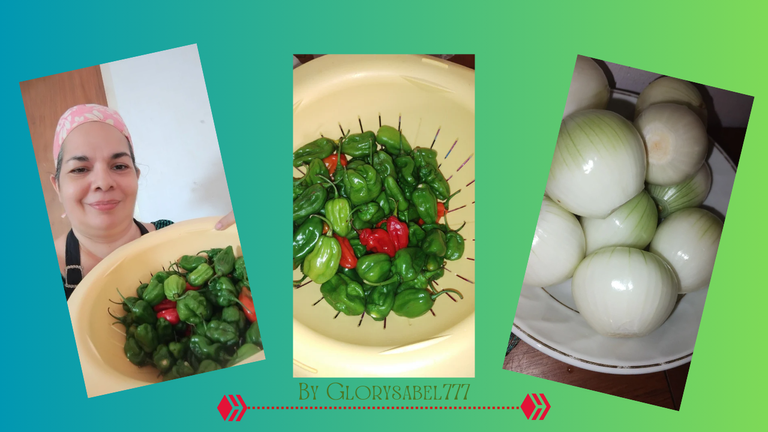

Ingredientes:
Guiso:
1 kg de carne de res (la que prefieras para guisar)
1 kg de carne de cerdo (pernil si así te gusta)
½ kg de tocino de cerdo
1 kg de gallina o pollo
800 gr de cebolla blanca
1 kg de cebollín (cebolla larga, ciboulet)
½ kg de ají dulce venezolano
200 gr de ajo
1 lt de caldo de la cocción de las carnes
½ lt de vino tinto para cocina
Aceite c/n
Onoto molido c/n
Sal al gusto
Pimienta al gusto
Masa:
3 kg de harina de maíz precocido amarillo (de la que usamos para hacer arepas)
Caldo de gallina o pollo c/n
Sal al gusto
Adornos:
250 gr de aceitunas rellenas de pimentón
250 gr de alcaparras
250 gr de pasas de uva
15 huevos cocidos
½ lt de vino tinto para cocina.
Amarrado:
2 bollos de hilo de algodón tipo pabilo.
English
Ingredients:
Stew:
1 kg of beef (whatever you prefer to stew)
1 kg of pork (pernil if you like it that way)
½ kg pork bacon
1 kg of hen or chicken
800 gr of white onion
1 kg of chives (long onion, chives)
½ kg of Venezuelan sweet chili
200 g of garlic
1 liter of meat cooking broth
½ liter of red cooking wine
Oil c/n
ground onoto c/n
Salt to taste
Pepper to taste
Mass:
3 kg of precooked yellow corn flour (the kind we use to make arepas)
Chicken or chicken broth c/n
Salt to taste
Ornaments:
250 gr of olives stuffed with paprika
250 g capers
250 g raisins
15 boiled eggs
½ liter of red cooking wine.
Moored:
2 balls of wick-type cotton thread.

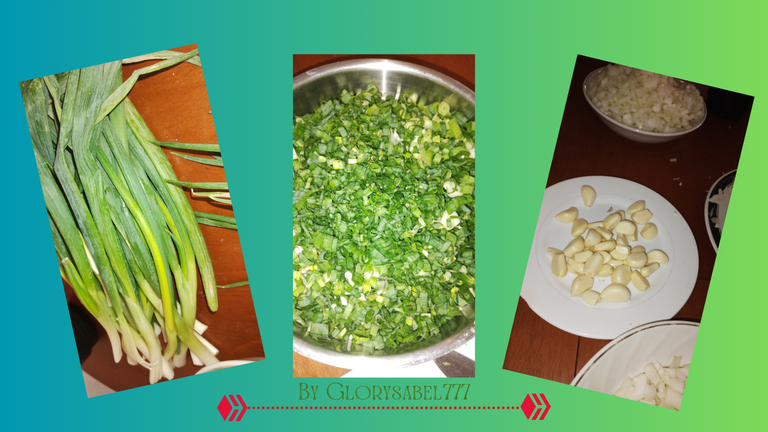
Preparación:
Guiso:
1.- Poner a cocer las carnes de res, cerdo y tocino en una olla con suficiente agua, y aliños al gusto, (ajo, hojas de laurel, pimienta en granos, ají dulce, ramas de cebollín) hasta que estén totalmente cocidas, pero no deshechas, deben quedar firmes ya que tendrán una segunda cocción.
2.- Poner en otra olla la gallina entera a cocer con aliños para darle sabor al caldo, ( igual a las carnes)
3.- Cortar todos los vegetales del guiso finamente, y reservar.
English
Preparation:
Stew:
1.- Cook the beef, pork and bacon in a pot with enough water, and seasonings to taste (garlic, bay leaves, peppercorns, sweet pepper, chive branches) until they are completely cooked. but not undone, they should be firm since they will have a second cooking.
2.- Put the whole chicken in another pot to cook with seasonings to give flavor to the broth, (same as the meats)
3.- Cut all the vegetables in the stew finely, and set aside.
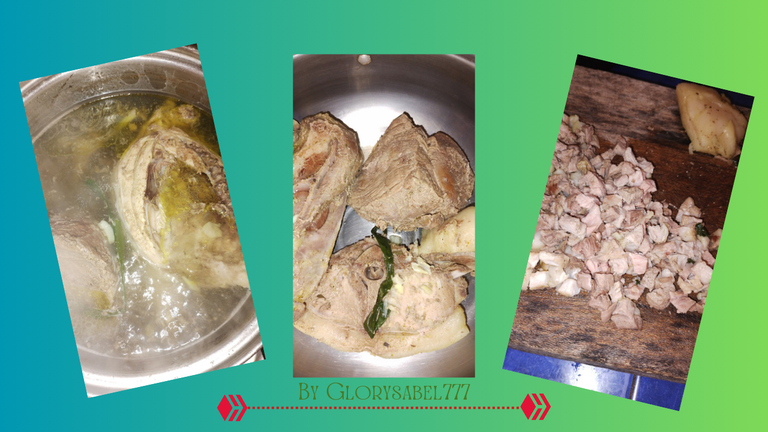
4.- Una vez las carnes y la gallina estén cocidas, dejar enfriar y cortar las carnes y tocino en pequeños dados, y deshuesar la gallina, desechar los huesos y cortar su carne también en trozos un poquito mayores que las carnes. Reservar ambos caldos.
English
4.- Once the meat and chicken are cooked, let it cool and cut the meat and bacon into small cubes, and bone the chicken, discard the bones and cut the meat into pieces a little larger than the meat. Reserve both broths.
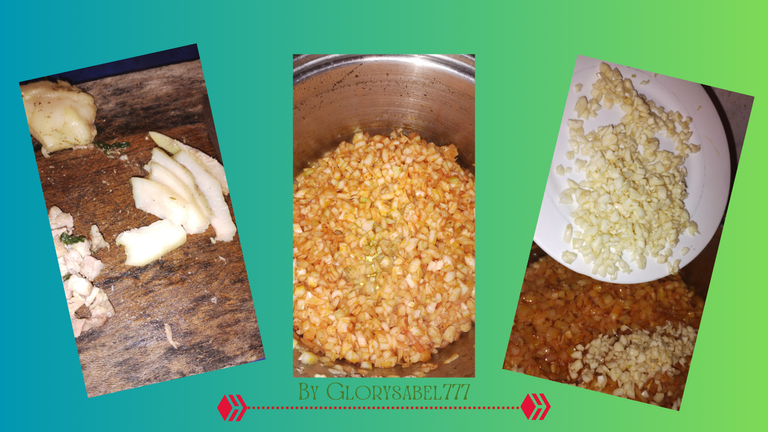 | 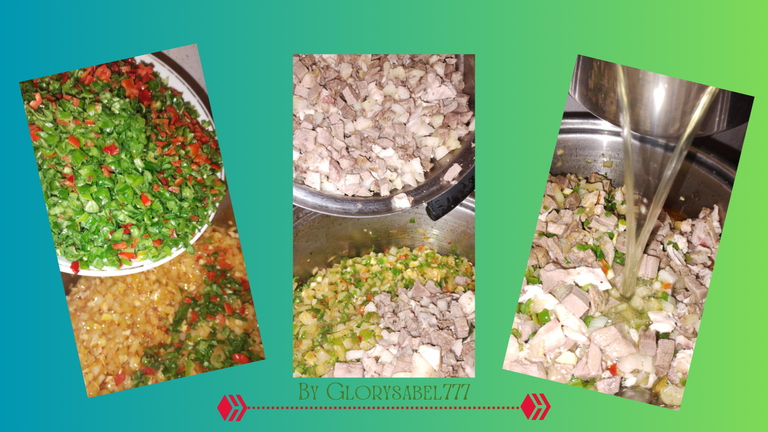 |
|---|
5.- En una paila bastante amplia colocar suficiente aceite y onoto molido hasta calentar, comenzar a sofreír el guiso en éste orden: cebolla, ajo, ají dulce, cebollín, luego las carnes, (res y cerdo) tocino y gallina, sazonar, agregarle el caldo de carne, tapar y dejar cocinar hasta que se integren los sabores. Para darle espesura al guiso vamos a diluir 1 tz de harina de maíz precocido amarillo, en 1 ½ tz de caldo de carne y se lo agregamos al guiso sin dejar de mezclar. Una vez haya espesado el guiso, rectificamos la sal ( debe quedar al gusto de los comensales) y en ése momento le agregas el ½ lt de vino, remueve bien, dejas que evapore el alcohol y ya está listo nuestro guiso.
English
5.- In a fairly large pan, place enough oil and ground onoto to heat, begin to fry the stew in this order: onion, garlic, sweet pepper, chives, then the meats, (beef and pork) bacon and chicken, season, Add the meat broth, cover and let it cook until the flavors are integrated. To thicken the stew we are going to dilute 1 cup of precooked yellow corn flour in 1 ½ cups of meat broth and add it to the stew while continuing to mix. Once the stew has thickened, we adjust the salt (it should be to the taste of the diners) and at that moment you add the ½ liter of wine, stir well, let the alcohol evaporate and our stew is ready.
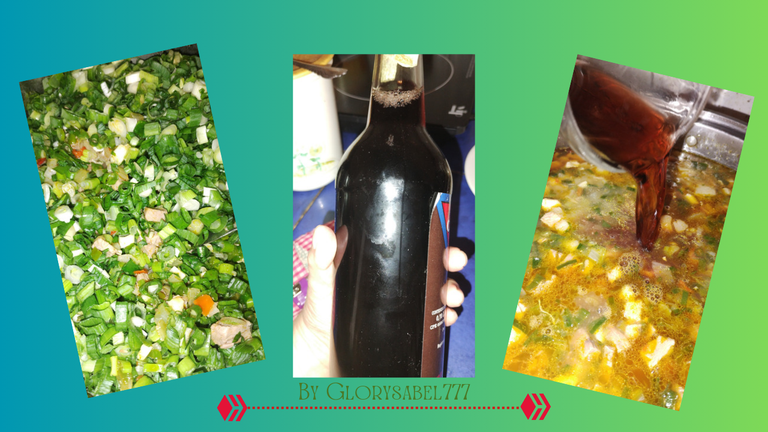
Masa:
La masa es un elemento súper importante en la Hallaca, no debe quedar dura ni demasiado gruesa, lo ideal es una consistencia suave y delgada que no le quite protagonismo al guiso, sino que lo complemente. No debe estar insípida ni demasiado salada. Por eso es importante usar las proporciones correctas de caldo y harina.
English
Mass:
The dough is a super important element in the Hallaca, it should not be hard or too thick, the ideal is a soft and thin consistency that does not take away from the stew, but rather complements it. It should not be tasteless or too salty. That's why it's important to use the correct proportions of broth and flour.
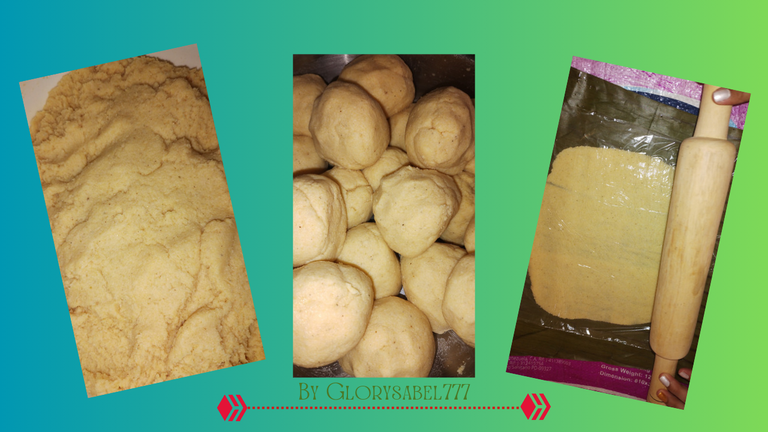
1.- Coloca en un bowl 4.320 litros de caldo de gallina bien sazonado y agrega de a poco 2.100 kg de harina de maíz precocido amarillo, deja reposar unos 5 minutos y amasa.
2.- Haz bolitas de aproximadamente 90 gramos.
3.- Extiende cada bolita finamente, en una porción de hoja de plátano de aproximadamente 30 cm, limpia y untada con un poco de aceite onotado.
4.- Apila las masas extendidas una sobre otra hasta el momento del armado.
Adornos:
English
1.- Place 4,320 liters of well-seasoned chicken broth in a bowl and gradually add 2,100 kg of precooked yellow corn flour, let it rest for about 5 minutes and knead.
2.- Make balls of approximately 90 grams.
3.- Spread each ball thinly, on a portion of banana leaf approximately 30 cm, clean and greased with a little oil.
4.- Stack the extended masses on top of each other until assembly time.
Ornaments:
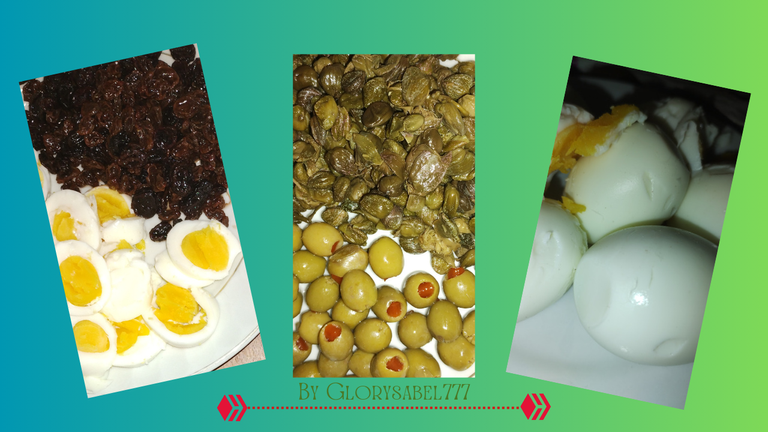
1.- Corta los huevos en rodajas de aproximadamente ½ cm de espesor.
2.- Pon a macerar las pasas de uva en abundante vino tinto.
3.- Elimina el exceso de sal de las alcaparras y escurre las aceitunas.
Armado:
1.- Coloca un cucharón de guiso en cada masa extendida, dispón sobre ella los adornos así: una rodaja de huevo, una aceituna, cuatro alcaparras, y cinco pasas de uva.
English
1.- Cut the eggs into slices approximately ½ cm thick.
2.- Marinate the raisins in plenty of red wine.
3.- Remove excess salt from the capers and drain the olives.
Armed:
1.- Place a ladle of stew on each extended dough, arrange the decorations on it like this: a slice of egg, an olive, four capers, and five raisins.
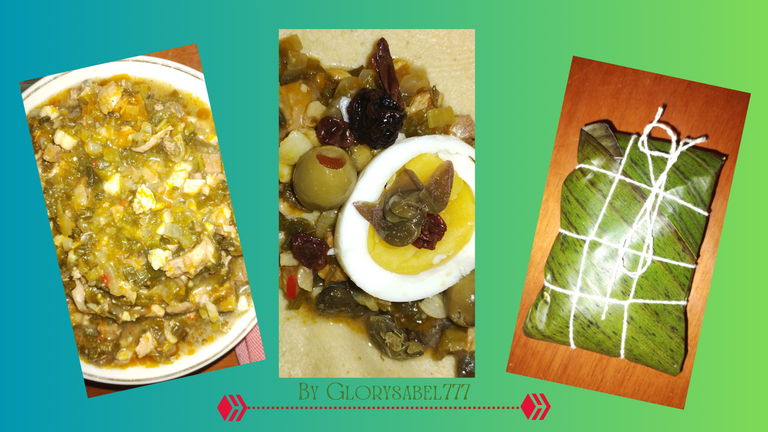
2.- Cierra cuidadosamente el paquete, doblando de manera que se forme un rectángulo, tan cómo si fuese un regalo.
3.- Finalmente asegura el paquete con un trozo de pabilo de unos 1.5 mts de largo, anuda para asegurar sin apretar en exceso.
4.- Lleva a cocción, ésto puede ser hirviendo las hallacas o cociéndolas al vapor. Con ½ hora de cocción será suficiente.
5.- Pon a escurrir tus hallacas, en un colador de pasta o una rejilla, hasta que se enfríen. Guarda en nevera para conservar. Y calienta nuevamente antes de consumir.
English
2.- Carefully close the package, folding it so that it forms a rectangle, as if it were a gift.
3.- Finally, secure the package with a piece of straw about 1.5 meters long, knot to secure without overtightening.
4.- Cook it, this can be by boiling the hallacas or steaming them. ½ hour of cooking will be enough.
5.- Drain your hallacas in a pasta strainer or rack until they cool. Store in refrigerator to preserve. And heat again before consuming.
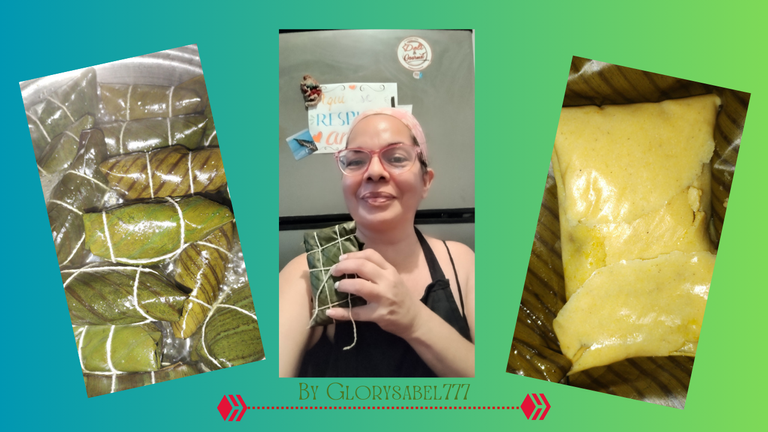
Con ésta cantidad te saldrán unas 75 hallacas aproximadamente.
Nota: al momento de comer debes retirar la hoja de plátano la cual no es comestible. Espero que las prepares, degustes y me cuentes.. ¡Buen provecho! Bendiciones 🙏
English
With this amount you will get approximately 75 hallacas.
Note: when eating you must remove the banana leaf which is not edible. I hope you prepare them, taste them and tell me... Bon appetit! Blessings 🙏
Nota: Todas las fotos de este post son de mi propiedad y uso exclusivo, sin excepción. Cámara del Teléfono: Motorola G53. Los banners fueron editados en Canva gratuito.
Note: All the photos in this post are my property and exclusive use, without exception. Smartphone Camera: Motorola G53. Banners were edited in free Canva.

Saludos son una delicia,pues no las he probado con huevo jeje
Te recomiendo que las pruebes.. ésta receta que les comparto es oriental monaguense, con un toque especial a la manera de Caracas ☺️. Si la preparas me cuentas que tal te parecen.. Feliz Año Nuevo y muchas bendiciones 🙏
Esas hallacas se ven que no llegan a enero de lo bueno que están. Hasta acá me legan los olores Glory.
Te deseo un feliz y prospero 2024.
Las hice el 22 y ya queda la mitad! 😂🤣 Y eso que sólo somos 4 en mi casa.. Feliz Año Nuevo amigo! Bendiciones 🙏🏻
The food in the pictures looks amazing, my mouth got watery after seeing such delicious recipe. The ingredients you have used must have made the food taste more tastier. I could feel the taste only through looking at the pictures.
!PIZZA
Thank you, they are indeed delicious! I'm glad that it caused you to taste my hallacas. I invite you to try it and prepare them so that you can try them now, and then tell me how it went. It was a pleasure reading you... come back soon! Blessings and Happy New Year! 🎉🙏🏻🥳
$PIZZA slices delivered:
@ayamihaya(2/5) tipped @glorysabel777
If one day my paths lead me to Venezuela, and around Christmas time, I am sure I will try Hallacas. ;)
Happy New Year, @glorysabel777 🙂
It would be wonderful, and a true honor for us Venezuelans, to welcome you to our land and serve you a Hallacas, and take you to see every corner of this beautiful land. Thank you for visiting my blog and leaving your beautiful comment. Blessings and Happy New Year to you too! 🥳🎉🇻🇪🙏🏻
Congratulations @glorysabel777! You have completed the following achievement on the Hive blockchain And have been rewarded with New badge(s)
Your next target is to reach 2250 upvotes.
You can view your badges on your board and compare yourself to others in the Ranking
If you no longer want to receive notifications, reply to this comment with the word
STOPCheck out our last posts:
Que ricas son las hallacas 🤤🤤 justamente para el 31 comí hallacas con huevo y me parece que saben muy bien.
Gracias por compartir la receta.
Me alegra mucho que te gusten las Hallacas con huevo, el truco es no pasar de cocción los huevos, así al momento de cocinar tus hallacas no tendrán un desagradable aro oscuro alrededor de las yemas ni las claras se pondrán gomosas.. si te animas a prepararlas recuerda etiquetarme o volver aquí y dejarme tus impresiones. Feliz Año Nuevo y bendiciones 🙏🏻
Gracias por esos tips amiga 🤤🤤🤤